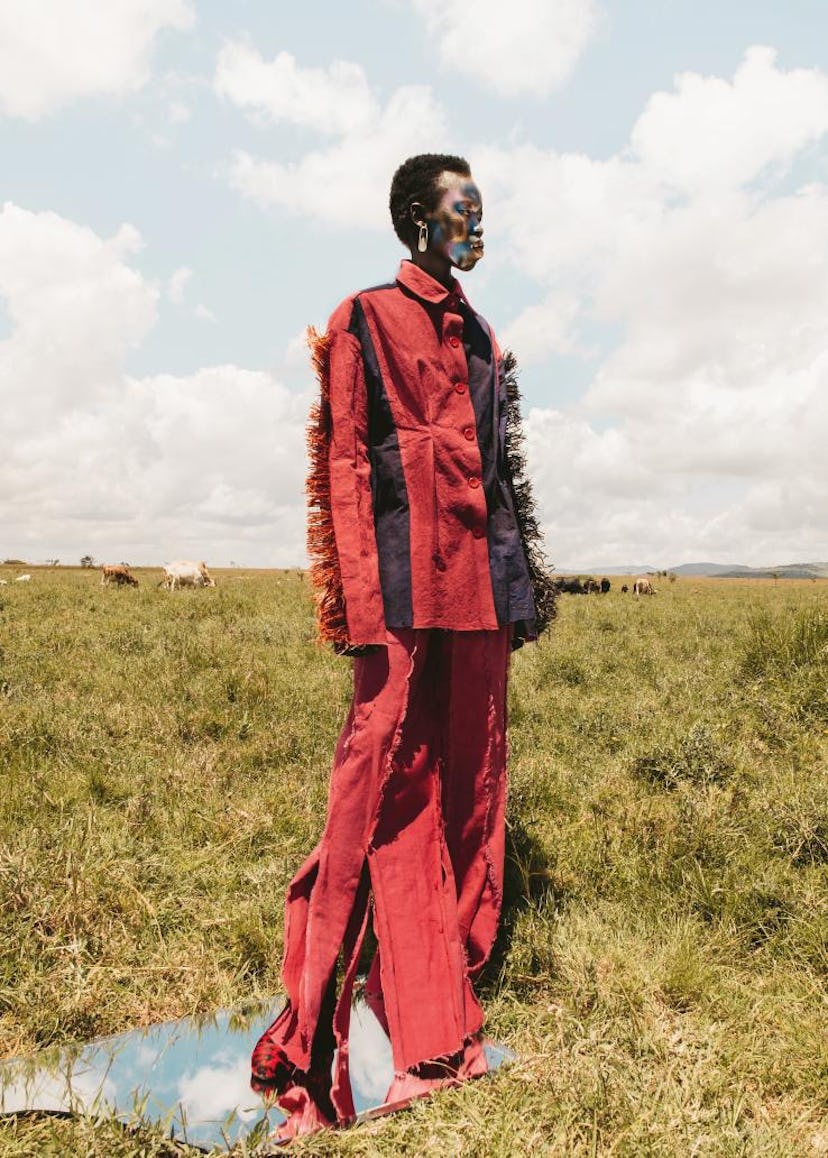Spotlighting the ‘Riches and Delights’ of African Fashion
In Africa: The Fashion Continent, Emmanuelle Courrèges features designers from Accra to Cape Town who are developing a new style vocabulary.

Emmanuelle Courrèges’s earliest fashion memories are all about self-expression: As a schoolgirl in Côte d’Ivoire, she and her classmates swapped out their navy uniform skirts for sarouel pants of the same color, a style typically worn by men that allowed for freedom of movement and a hint of rebellion. She remembers admiring how Aminata Traoré, the Malian Minister of Culture and a family friend, combined traditional garments with accessories by young designers to create “innovative, original silhouettes.” Her early visits to designer Chris Seydou’s workshop in Abidjan were also formative—his atelier was a meeting place for the region’s most stylish women.
“I was lucky enough, thanks to my family, to grow up surrounded by African intellectuals, journalists, sociologists, and artists who have nourished my thinking,” says Courrèges, a French journalist who has contributed to Elle, Marie-Claire and Vogue Italia, and spent the first 18 years of her life between Cameroon, Senegal, and Côte d'Ivoire. While her work has covered a broad swath of social and political topics, fashion has been an interest for decades, as a craft, a business, and a cultural barometer. “Fashion is a language,” she tells me. “I have always thought that clothing and style are great ways to tell us about societies and the state of the world.”
Zineb Koutten wears a jacket by Aybee. Photographed by Joseph Ouechen.
The Moroccan artist Karim Chater photographed by Mohcine Harisse.
Her thoughtful, beautiful new book, Africa: The Fashion Continent (Flammarion), invites readers to explore the complex landscape of contemporary African fashion—each chapter spotlights boundary-pushing designers and artisans, savvy boutique owners, photographers, stylists, and young creatives who are each coming up with their own versions of what “African fashion” means, and spearheading a movement that Courrèges compares to the Swinging ’60s in London. “This book is not just a book about clothes,” Courrèges emphasizes. “It is about how the fashion of designers and the style of young people bear witness to the changes taking place on the African continent, but also to the dreams, demands or passions of these new generations.”
The book is a timely project, given the fact that designers from various African countries are beginning to gain global recognition: South African designers Thebe Magugu and Sindiso Khumalo have both been awarded the LVMH prize, Cameroonian designer Imane Ayissi is on the official Haute Couture calendar, and Nigerians Kenneth Ize and Maki Oh show at Paris and New York fashion weeks, respectively. But as Courrèges writes in the book, even with increased visibility, African fashion “remains incomprehensible for many.”
“There is still a lot of work to be done to make the voice of creators heard and clichés to be broken down,” she says. Part of that involves a nuanced understanding of the legacy of colonization, which she and her subjects address plainly in the book: “Seventy years ago, in some countries, you were forbidden to speak your language. Being yourself was something that was often prevented,” she says. “What designers are doing today is not only beautiful or daring, it is also revolutionary. They are inventing a language of incredible richness, drawing their vocabulary from all the cultures of the world.”
The book’s cover features the designer Lafalaise Dion in a headdress of her own design. Photographed by Daron Bandeira. © Africa: The Fashion Continent, by Emmanuelle Courrèges, Flammarion, 2022.
Another major theme in the book is the way many designers and craftspeople approach sustainability not as a cresting trend to be caught up with, but as an intrinsic part of what people in their communities had already been doing for centuries. (“The Western world has a propensity to think that everything that is done elsewhere is the consequence of what it has created itself,” Courrèges quips.) She cites the Ghanaian label Studio One Eighty Nine, which uses GOTS-certified organic cotton grown in Burkina Faso for their beachy dresses, and the Senegalese designer Selly Raby Kane, who makes patchwork skirts out of upcycled fabrics inspired by deep-seated legacies of transformation and resourcefulness, as examples of brands for whom sustainability is a central tenet.
Models wear clothing and accessories by TSAU, a brand by the London-based Ghanaian artist and designer Bevan Agyemang. Courtesy of Flammarion.
Such critical observations are balanced with a visual feast: the cover features the designer Lafalaise Dion in a headdress of her own design; inside, you’ll find hundreds of inspiring runway and look book images, plus street style shots from Accra to Lagos. Also in the mix are featurettes on artists like Hassan Hajjaj, Trevor Stuurman, and Laetitia Ky, who share their candid thoughts on creativity and representation.
While your immediate takeaway after reading may be that you should be adding more African designers to your closet (if you need ideas for where to look, Courrèges recommends Industrie Africa, The Folklore, Elle Aime Creatives, and Moonlook), Courrèges hopes that her work sparks reflection, discussion, and action. “Just because we do not understand or see something does not mean that it does not exist,” she says. “If we agree to decentralize the Western point of view, we discover the exceptional richness that is hidden behind these creations. In an increasingly saturated fashion industry—where many brands are all doing the same thing, where we keep looking back to the ’70s, ’80s or ’90s—what African designers bring to the table, their discourse, their vocabulary, their textiles, their view of the world, is something profoundly delightful.”